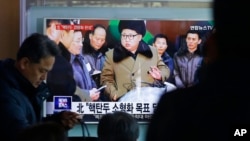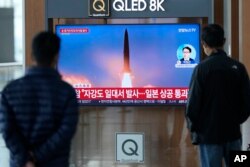Experts anticipating a North Korean nuclear test are saying the event would likely involve miniaturized nuclear warheads designed to fit cruise missiles that can target South Korea.
The explosive power would be similar to that of the nuclear bombs the U.S. dropped on the Japanese cities of Hiroshima and Nagasaki in August 1945 to end World War II, experts said.
On Tuesday, South Korean President Yoon Suk Yeol, speaking before the National Assembly, said North Korea has completed preparations for the seventh nuclear test.
State Department Spokesperson Ned Price said Monday the U.S. is "preparing for all contingencies" to deal with "the potential for another North Korean nuclear test."
VOA's Korean Service contacted North Korea's U.N. mission in New York City asking for comments on Washington and Seoul's assessment of its potential nuclear test but did not get a reply.
Satellite images first revealed signs of North Korea's preparations at its Punggye-ri test site in March, and preparations have continued since then.
South Korea's National Intelligence Service assessed the nuclear test could come between October 16 and November 7.
North Korea conducted six nuclear tests between 2006 and 2017.
Prelude to nuclear test
Experts said North Korea's seventh nuclear test is likely to follow recent rounds of missile launches.
Jim Walsh, a nuclear expert at the Massachusetts Institute of Technology's (MIT) Security Studies Program, said North Korea's previous six nuclear tests were "preceded by an escalating series of missile tests."
North Korea said on October 10 that a spate of short-range missile tests and an intermediate-range missile test between September 25 to October 4 were aimed at conducting tactical nuclear drills to assess "nuclear counterattack capability."
Pyongyang test-fired two long-range cruise missiles capable of carrying nuclear weapons on October 12 and said the launches were to check "the operation of tactical nukes," according to a report the next day by the official news outlet, KCNA.
Olli Heinonen, former deputy director general of the International Atomic Energy Agency (IAEA) who is now a distinguished fellow at the Stimson Center, said North Korea is likely to "do some nuclear tests in order to manufacture miniaturized tactical nuclear weapons" Pyongyang has discussed.
Tactical nuclear weapons refer to short-range missiles capable of carrying small nuclear warheads designed to be used in battlefields. Tactical missiles include short-range ballistic missiles that are approximately 1.2 meters wide and 6.4 meters long and can travel about 1,000 km or less.
For nuclear warheads to fit on short-range missiles, the devices must be small and lightweight.
Fitting into cruise missile
In the anticipated nuclear test, experts said Pyongyang could test even smaller nuclear warheads than ones that could be mounted on short-range ballistic missiles.
They said North Korea could test nuclear warheads that fit into long-range cruise missiles. These are half the diameter of short-range ballistic missiles.
Ankit Panda, a nuclear policy expert at the Carnegie Endowment for International Peace, said that North Korea probably already has compact nuclear warheads developed by 2017 that can be mounted on short-range ballistic missiles.
"When they test this new [nuclear] device, it may be even more compact, allowing them to place it on very short-range missiles, guided short-range ballistic missiles, and possibly even long-range cruise missiles which they've been testing recently," Panda said.
A typical long-range cruise missile like the U.S. Tomahawk is about .53 meters wide and 5.6 meters long and can fly about 1,600 km.
North Korea launched two long-range cruise missiles on October 12 that flew 2,000 km, according to the KCNA. The two missiles can cover the entire range of the Korean Peninsula, which is about 1,200 km long.
Cruise missiles are difficult to detect as they can fly at low altitudes to evade missile defense systems.
Explosive yield
Experts said the explosive power of diminutive nuclear warheads on tactical missiles would be relatively low.
"If the test is for a small, lightweight nuclear weapon intended for delivery by a short-range missile [i.e. a 'tactical' nuclear weapon], then I would expect the yield to be relatively low, perhaps less than 10-20 kilotons," said Gary Samore, who served as the White House coordinator for arms control and weapons of mass destruction during the Obama administration.
Each of the two nuclear bombs dropped in Hiroshima and Nagasaki in 1945 had explosive yield of about 15 kilotons. Approximately 80,000 people in Hiroshima and 40,000 in Nagasaki are estimated to have died immediately from the bomb blast. Additional tens of thousands died from radiation and other injuries.
By comparison, a larger nuclear warhead such as a thermonuclear device has explosive yield of at least 100 kilotons or 1,000 tons of TNT. Samore said such thermonuclear devices are intended for strategic nuclear weapons or larger nuclear warheads on long-range missiles.
"Warheads for tactical and intermediate-range missiles might be in the range of power of the Hiroshima and Nagasaki bombs," said Frank von Hippel, former assistant director for National Security at the White House Office of Science and Technology Policy and co-founder of Princeton University's Program on Science and Global Security and the International Panel on Fissile Material.
Hans Kristensen, director of the Nuclear Information Project at the Federation of American Scientists, said, "North Korea's previous tests had limited yields considered suitable for tactical nuclear weapons [from a few to 15 kilotons]."
He continued, "If the priority is to develop an operational warhead for tactical missiles, we might see a test with a yield similar to what we saw in 2009-2016, perhaps a little more powerful." Kristensen added that only the sixth nuclear test in 2017 had a very large yield.
Experts said Pyongyang would use plutonium when miniaturizing nuclear warheads rather than uranium, which is heavier.
David Albright, a former U.N. nuclear inspector and the current president of the Institute for Science and International Security, said there is a chance Pyongyang might test a two-stage thermonuclear device that would use both plutonium and uranium to produce a higher explosive yield.
Such a device would be used in strategic nuclear weapons.
Von Hippel said by having and using tactical nuclear weapons against South Korea, Pyongyang "would still have left the leverage of being able to threaten to attack the U.S.," with strategic nuclear weapons.
South Korea's Vice Foreign Minister Cho Hyun-dong said on Tuesday during his meeting with U.S. Deputy Secretary of State Wendy Sherman that North Korea will face an "overwhelming and decisive response" if it uses a nuclear weapon.












